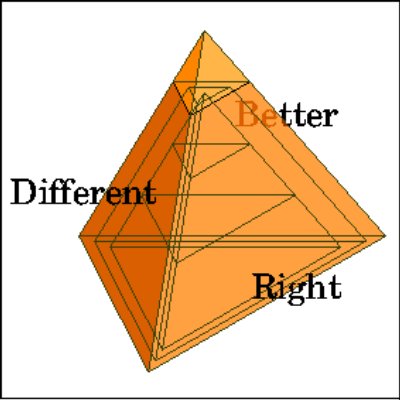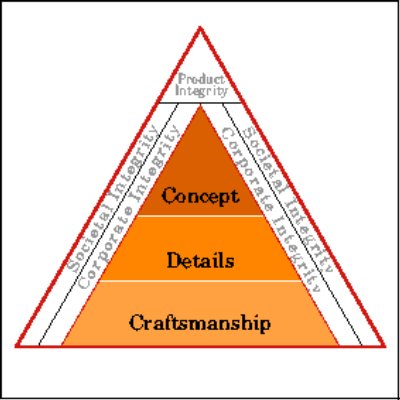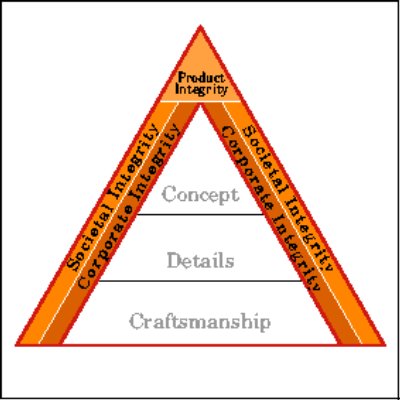Introduction: Seldom a hot topic now, quality was the holy grail for business fifteen to twenty years ago. At the time, the automotive industry was learning the hard way from Japan that buyers could recognize quality and appreciate it enough to make it a priority in choice-making. The lesson was largely framed through the lens of manufacturing and the concepts of quality control developed by Edwards Demming – a prophet embraced by the Japanese, ignored in America and, suddenly, as important at home as he was abroad. We (and other countries) learned the lesson, and products worldwide became notably more reliable, longer-lasting and less subject to defects. Today’s automobiles routinely operate over lifetimes twice what was reasonable twenty years ago, and do so with environmental wear and tear barely noticeable, even in our harsh winters and summers. As a single, concept-encompassing word, quality was a good choice for a rallying cry. It embraced goals and functionality within the power of industry to understand and apply.

Figure 1: The Quality Pyramid
The Quality Pyramid
And it still has currency. Today, it need only be viewed through another lens to bring new insights. A particularly useful view is through the lens of design innovation. I like to use a diagram I call the Quality Pyramid (Figure 1 above) to show how design innovation can play a central role in the achievement of quality. It allows me to make distinctions and tease apart the subtle differences in how and where design innovation affects a company – or an institution, an industry, even an entire country.
The Quality Pyramid has a core, a capstone and sheathing layers. At its core (Figure 2) are the design contributions that produce innovation. These occur at three levels, corresponding to where innovation can be introduced from the time a product is envisioned to the time it is produced.
At the level closest to production, design innovation is directly concerned with how the product, communication or system is actually formed and assembled. For manufactured products, this is the province of the product designer and design engineer. For products of the service and knowledge industries, this is where communication designers and information architects shape final details. For all, craftsmanship is a major goal. Design innovation here can make the production process smooth, efficient and devoid of procedures that might introduce inaccuracy or error. The intent is a design that can easily be produced with the high craft of the perfectly made product – a product better because it has been thoroughly thought through.
At the next level, innovation is concerned with the details of design: how the product performs its functions, how it meets its users’ physiological and cognitive capabilities, and how it fits into the cultural landscape of its users’ world. Form, function, style and human factors all contribute to aspects of quality here that make the product right – sensitively positioned and tuned to the needs and aspirations of its users.
Finally, at the highest level of the design core, design innovation is directed toward concept. Most challenging of the contributions that design can make, a good concept truly separates a product from its competition. Great concepts are culture changers, instigating watershed changes in how we live. In modern times, major examples include radio, the telephone, television, the automobile, air travel, the computer, the Internet and many other now commonplace products and systems. But examples at much more modest levels also can reach the status of notable concepts. Among such are the zipper, Velcro, Post-Its, the Walkman, fiber-tipped pens, cell phones and many other things we accept as necessary accessories in our lives today. The new Segway transporter may be changing culture now.
At the levels of Craftsmanship and Details, the roles of design innovation are relatively clear and the processes for making good design happen are well understood. At the Concept level, less is known – great concepts frequently have come unrequested from individuals inspired by personal motivations, often driven to persistence well beyond normal achievement. Many of the great inventors of the 19th and early 20th centuries fit this description. Today, innovation is no longer acceptable as an unrequested, random event. The press of world trade and international competition has made reliable, predictable innovation a requirement rather than a curiosity. As a result, advanced planning processes for concept development are beginning to appear; Structured Planning is an example.
Industries and institutions will learn to use them – to remain viable they will have to learn to obsolete themselves. Conceptual design innovation will be critical; its product uniquely different – and freshly imagined.

Figure 2: Design Contributions that produce innovation
Integrity: Product, Corporate and Societal
Topping the Quality Pyramid is its capstone, Product Integrity (Figure 3 below). The progressive achievement of design quality at the core levels leads to products that have integrity. They work well, work easily for those who use them, and fit well into the social expectations of their users’ world. They are well made, reliable, sensitive to human and environmental needs and stand out as conceptual leaders in meeting new opportunities.
In a word, they have integrity, a systemic wholeness of quality that is the culmination of integrating all three levels of design innovation. The two sheathing layers of the Quality Pyramid symbolize the permeating influence of product integrity on institutions and society. The inner layer symbolizes the cumulative effect of product integrity on an organization responsible for the development and deployment of products with integrity. Companies and institutions that produce great products soon become known for them. Buyers begin looking for the organization’s “brand” and (often gratefully) give up natural skepticism and cautionary evaluation – “The product must be good, it’s a ____”. This happened with Sony in the 1960’s and ’70’s. Its products became so well regarded, people began purchasing them with little or no comparison shopping. The achievement raised Sony, as an organization, to Corporate Integrity status.
At an even higher level, it is possible for the influence of product integrity to extend to entire societies. Japan again provides a good example. Before World War II, Japanese products were generally perceived as inferior. After the war, the new Japanese ministry responsible for export control decreed that products for export to the U.S. must be at least as good as or better than competitive products in the market. The result was an almost overnight reversal of public opinion.
Notable among early products marketed were cameras which proceeded to overwhelm U.S. high-end camera production and provide stiff competition for all including the very highest-level European cameras (Leica, Hasselblad). Consumer electronics followed, and within a very short time, “Made in Japan” signified status at the Societal Integrity level.
Companies such as Nikon, Sony and Canon became household names with unique identities supported in this country and elsewhere by corporate identity programs. As design contributions, identity and branding are important for unifying and communicating an organization’s image. But design contributions of this form should not be confused with those employed to achieve product integrity. Public sophistication has grown, and it is not enough now to be recognizable. The ubiquitous media add new layers of information almost continuously to the image that an organization presents. When anything less than laudable is revealed, years of image building can be overridden – witness the 2005 explosion at the BP refinery in Texas. The revelations that surfaced about misguided corporate policies were devastating to a company already highly recognizable and within striking distance of achieving corporate integrity. Its innovative, responsible approaches to energy research and development were not enough.
Corporate integrity is not easily attained, and once achieved requires continual nourishment. The definition of integrity specifies “wholeness” and “completeness”, properties substantially exceeding the “oneness” and “individuality” required of identity. A company or institution good enough to achieve corporate integrity will not only exhibit in its products the full range of design innovation depicted by the Quality Pyramid, but will demonstrate unimpeachable conduct in its internal operations as well as its relations with the public.

Figure 3: Product Integrity

















